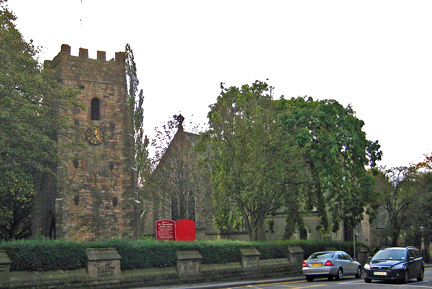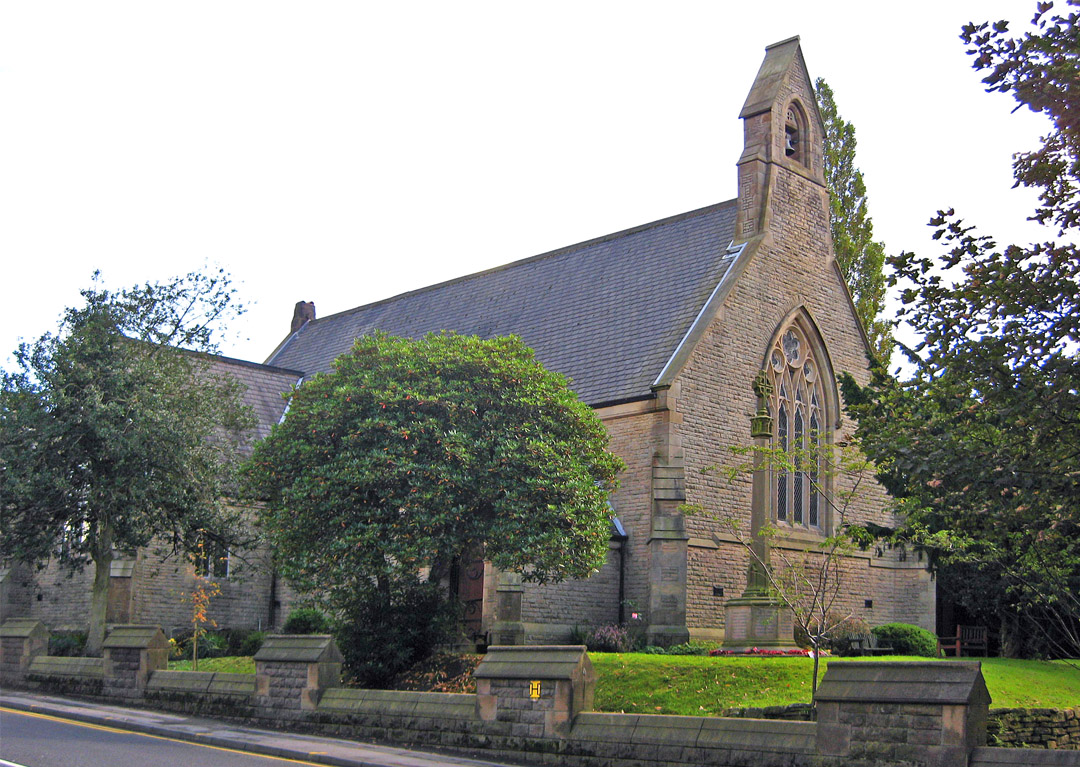 |
The Church of St Maxentius, Bradshaw |
 |
BRADSHAW CHURCH
 | |
 | |
From The Bolton Journal and Guardian, Friday, June 5, 1936, reproduced here by the kind permission of the Bolton News.
The Rev. S.H. Martin’s coming departure from Bradshaw to take up the Rectory of St. Michael with St. Nicholas, Sutton, Herefordshire, makes it unlikely, one feels, that we shall know why Bradshaw Church was dedicated to an obscure French saint – St. Maxentius. Bradshaw is the only church in England so dedicated and St. Maixeut, in the department of Sevres, mid France, is the only other place where his name is remembered.
There are many curious features about Bradshaw – it has a row of houses whose back-doors face the main street, one of its public houses is “The House Without a Name,” its church has no tower, and there is an old tower still standing without a church.
Bradshaw has its roots firmly embedded in the past, and the village – which has in recent times lost some of its rurality – can boast a history as long as the oldest parts of Bolton.
The oldest link with the past that Bradshaw possesses is the old bell, the date of which has been given by an expert as the early 15th century or late 14th century.
But even if it was cast in say, 1400, it does not, of course, prove that there was a church at Bradshaw in that year, the bell may have been originally cast for some other church. There is in fact a tradition that it came from Yorkshire, but it is possible that a church – more likely a chapel – existed at Bradshaw before the old church to which the ancient tower belongs, was built.
The first reference to a church at Bradshaw is found in a list of clergy for the Archdeaconry of Chester drawn up in 1641-2, in which the Rev. John Hilton is given among the five clergymen in the Bolton parish. As he was presented by John Bradshaw it is assumed that he had charge of the chapel at Bradshaw.
Mr. Hilton is, therefore, the first known incumbent of Bradshaw. The John Bradshaw who presented him belonged to a family which had great influence in this part of Lancashire, and it is quite possible that they helped to build and maintain a chapel a Bradshaw. The Bradshaws were, in fact, resident in the parish as early as 1246.
In his excellent history of Bradshaw parish Mr. Martin suggests that the origin of the church was due to the desire of the Bradshaw family for a place of worship nearer home than Bolton Parish Church.
John Bradshaw’s will – he died in 1543 – refers to “ye chapell fieldes,” and thus bears out the belief that there must have been a chapel at that time. The name Bradshaw Chapel at the corner of Bradshaw-rd. and Lee Gate-lane doubtless thus provides a link with pre-Reformation days.
On a map of the county made in 1610, Bradshaw Chapel is distinctly marked. Thus it is probably that there was a chapel at Bradshaw 400 years ago and possibly even earlier.
In 1646 certain money was provided for a stipend of a minister at Bradshaw, and about six years later, the Bradshaw family apparently rebuilt or repaired the old chapel.
About this time during the Commonwealth, a board of clergy and laity called the Bury Classis controlled the church affairs of the district, and in 1649 the Classis appointed the Rev. Samuel Fellgate to be minister at Bradshaw.
The Bradshaw family were Puritans, and it is not surprising to find that the Rev. Oliver Heywood, the Puritan divine, preaching a funeral sermon at the chapel in 1669 on the death of his uncle Francis Critchley.
In 1694 the Bradshaw family sold their possessions in the parish to their cousin, Henry Bradshaw, of Marple Hall, Cheshire, son of the famous regicide, and left the district - an event which seriously affected the chapel which had hitherto been almost entirely supported by them.
Parishioners could barely keep the church going, and in 1722 Dr. Gastrell, Bishop of Chester, wrote that “the church was then decaying, and nothing at all belonged to it, the minister being maintained by voluntary contributions which amounted to £12 per annum.”
Two years later, however, the church had apparently been repaired. During the 18th century £600 was given by Queen Anne’s Bounty and £400 by another benefactor to endow the living, most of the money being used to purchase two farms.
The church was again rebuilt – of brick and stone – in 1770, the church being extensively altered in the process. It was a squat building when finished with ugly windows. Early in the 19th century the day and Sunday schools were founded, the old Sunday school being held in what is now the village Post Office.
There are some still living who can remember the Rev. Philemon Alfred Galindo, who was vicar from 1844-77. During his vicariate the Sunday school flourished and there was increasing interest in the welfare of the church. The year 1833 was notable for the delimitation of parish boundaries, which practically constituted Bradshaw a separate parish, although permission to celebrate marriages in the church was not granted until 1857.
The old building was by this time very dilapidated and too small for the population, and an appeal for funds for a new church went out in 1846. By 1859 £2,014 had been promised. The foundations were laid, but then building was delayed for 10 years. When Mr. Thomas Hardcastle succeeded to his father’s property the scheme was reopened and the building began to rise. It cost £4,300, half of which, at least, was given by Mr. Hardcastle. In fact Bradshaw is indebted to him for its schools and its church.
The new church was consecrated on November 9th, 1872 b y Dr Fraser, Bishop of Manchester. The organ was opened the following year.
Mr. Galindo was succeeded in 1877 by the Rev. R.K. Judson, who remained vicar until 1915, when he resigned through ill-health. He was followed by the Rev. S.H. Martin, whose successor has not, as yet, been appointed. Thus the last three incumbents cover a period of 92 years - an average of almost 33 years each.
| Bolton Home & Contents | ©Lancashire OnLine Parish Clerks | Lancashire Home |